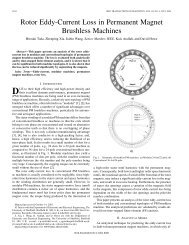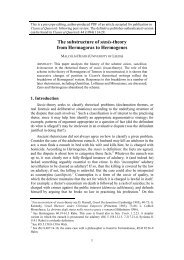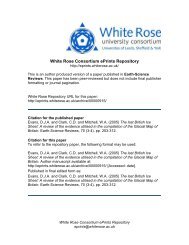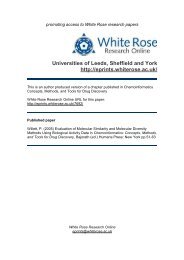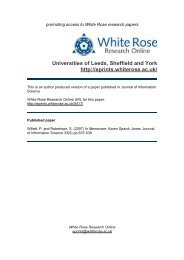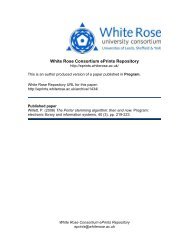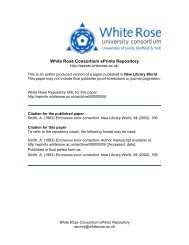The archaeological context of the Iwo Eleru cranium from Nigeria ...
The archaeological context of the Iwo Eleru cranium from Nigeria ...
The archaeological context of the Iwo Eleru cranium from Nigeria ...
You also want an ePaper? Increase the reach of your titles
YUMPU automatically turns print PDFs into web optimized ePapers that Google loves.
<strong>the</strong> ArchAeologicAl <strong>context</strong> <strong>of</strong> <strong>the</strong> iWo eleru crAnium <strong>from</strong> nigeriA<br />
Figure 12 a and b. Coordinates <strong>of</strong> neurocranial osteometric landmarks.<br />
A new geometric morphometric study <strong>of</strong> <strong>the</strong> cranial configurations in specimen space (Rohlf and Marcus,<br />
vault<br />
Figure 12 1993; b O’Higgins, 2000; Harvati, 2003a,b; Harvati et al.,<br />
2007). Geometric morphometrics also readily account for<br />
Recently a primary replica <strong>of</strong> <strong>the</strong> cranial vault <strong>of</strong> <strong>the</strong> size correction and provide a way <strong>of</strong> quantifying shape<br />
<strong>Iwo</strong> <strong>Eleru</strong> specimen, produced before its return to variability <strong>of</strong> traits which are difficult to measure with<br />
<strong>Nigeria</strong>, was digitized by Harvati and included in a 3-D conventional measurements and are <strong>the</strong>refore usually<br />
geometric morphometric multivariate statistical analysis. described qualitatively (Harvati, 2003a; Nicholson and<br />
Comparisons <strong>of</strong> Stringer’s measurements on <strong>the</strong> original Harvati, 2006, Gunz and Harvati, 2007). <strong>The</strong> geometric<br />
and <strong>the</strong> replica show a maximum discrepancy <strong>of</strong> 1 mm, morphometric study <strong>of</strong> <strong>the</strong> <strong>Iwo</strong> <strong>Eleru</strong> specimen included<br />
suggesting that <strong>the</strong> replica accurately reflects <strong>the</strong> original curve (semilandmark) as well as landmark data. Thus <strong>the</strong><br />
shape <strong>of</strong> <strong>the</strong> <strong>cranium</strong>. <strong>The</strong> goal <strong>of</strong> this study was to analysis quantifies not only overall cranial shape, which<br />
evaluate <strong>the</strong> cranial shape and size <strong>of</strong> this specimen in is also reflected by traditional measurements, but also <strong>the</strong><br />
<strong>the</strong> <strong>context</strong> <strong>of</strong> Middle and Late Pleistocene and Holocene detailed shape <strong>of</strong> particular anatomical regions, such as <strong>the</strong><br />
human morphological variation in order to fur<strong>the</strong>r assess supraorbital morphology.<br />
its affinities and phylogenetic/population relationships.<br />
Data were collected in <strong>the</strong> form <strong>of</strong> three-dimensional<br />
Geometric morphometric approaches are complementary coordinates <strong>of</strong> neurocranial osteometric landmarks, defined<br />
to and expand on traditional multivariate analyses based as homologous points that can be reliably and repeatedly<br />
on linear and angular measurements, such as those located, using a Microscribe (Immersion Corp., 1998)<br />
conducted by Stringer. <strong>The</strong>se coordinate-based methods portable digitizer. Landmarks along <strong>the</strong> midsagittal pr<strong>of</strong>ile<br />
better preserve <strong>the</strong> geometry <strong>of</strong> <strong>the</strong> objects studied <strong>from</strong> glabella to inion, along <strong>the</strong> coronal and lambdoid<br />
and allow intuitive visualization <strong>of</strong> shape differences sutures, and along <strong>the</strong> upper margin <strong>of</strong> <strong>the</strong> supraorbital<br />
between ei<strong>the</strong>r individual specimens or group mean shape torus were also registered (Figure 12). <strong>The</strong> points along<br />
39<br />
a<br />
Figure 12 a<br />
b




